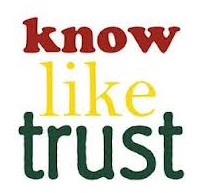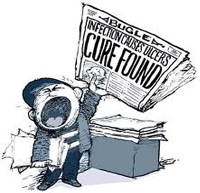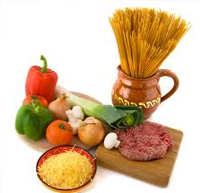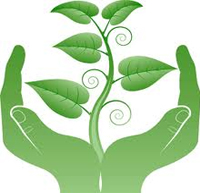Discover how newsletters can help you transform your business into a super successful entity with hoards of ‘raving fans’?
1 – Newsletters Can Help You Keep Customers
 We all know that getting someone to buy a second time costs about 1/6th the effort as getting a new customer. But where do we spend most of our marketing dollars? On getting new customers…
We all know that getting someone to buy a second time costs about 1/6th the effort as getting a new customer. But where do we spend most of our marketing dollars? On getting new customers…
Why is this? Mostly it is habit. We think that we need more business, and therefore we need new customers. But we don’t need as many new customers if your existing customer base is well-nurtured and feels looked after. Existing customers generally need to repeat purchase at some point – there are very few genuine ‘one-and-done’ businesses around, so continuing to stay in touch with them between purchases means they are more likely to buy from you the next time they need your products and services.
A print newsletter is a way to keep marketing to your existing customers without them realizing they are being marketed to. You can show up in their letter box every month. You can deliver great value to them with fun, interesting relevant content making their lives a little better. You aren’t perceived as selling overtly. And you can make them an offer every month too – giving them a chance to repeat. Point-black, there is a simple formula you need to follow if you want to keep your customers. We call it the 12 to 24X formula.
2 – Customer Retention And The 12 To 24X Formula
Let’s you look at your business like a farming operation. Your aim is to work a lot like a rice farmer. You see rice paddies actually get more productive the more fertiliser and hard work you put on them. You know those small family plots in rural Japan and China — the farmers are willing to work them so hard because they know that no matter how much they put in they will be rewarded even more come harvest time.
You can achieve something similar by understanding that your customers are similar to those rice fields. The more you put into them, the more you can get out of them. The way to do it is with the 12-24X formula.
Basically, you will stay in your customers’ minds and they won’t wander off or be swept away with your competitions’ offers if you stay in touch with them 12-24 times a year. This means you need to get in touch with each customer 12-24 times a year outside of sales offers and outright/blatant pitches.
With a monthly newsletter, you get the bare minimum 12 touches and then you can look to add season greetings, such as birthdays, Christmas, Easter, Anniversaries of conducting business, whatever is right for your customers.
But that monthly customer newsletter is the bedrock of the 12-24X formula. Of course you could take it to a whole new level using the internet, by sending out a touch every week or every day. It is entirely up to you. Before we get carried away with ourselves, start with the basics: a monthly print newsletter in their mailbox every month.
3 – Get New Customers
Newsletters have great pass-along value. More so than any other sort of marketing materials. They even seem to do better than education materials, such as case studies and reports or white papers. If an article in a newsletter is relevant, the recipient will pass it along to other people for the sake of keeping them in the loop.
So, say you sell shoes, and your newsletter has an article about how to know which shoes stay comfortable the longest, then one of your customers is probably going to pass it along to other people they know if they mention that their shoes are making their feet hurt… And odds are, they will tell that person:
A) they are a customer of yours, and
B) will point out to the prospect exactly what they should be reading…
Ta-dah. Referral.
How good is that?
How does that compare to other ways to get referrals? Most of them are a little less subtle.
Things like posters on the wall for choice of gifts with referral… Sending out referral solicitations…. Share with friends links in emails… Asking for referrals to the client’s face. None of them are as natural as passing along your newsletter and honestly telling the another person that they should be doing business with you.
Probably the best company in the world at getting referrals is Disney, and they work really hard at it. Their mission is to make your experience at Disney Land so magical that you can’t help but go home and tell seven people about it. That is a lot of work. It is also outside the budget of most of us mere mortals. A customer newsletter is very cheap by comparison, and it can be made to stealthily obligate customers into referring without them evening knowing it.
4 – Make Yourself The Credible Expert
 Who publishes newsletters?
Who publishes newsletters?
That’s right, experts.
So if you want to be seen as the expert in your market, then what should you do?
That’s right, publish a newsletter. Experts know more than other ‘vendors’ and by logical extension, more competent. However, in many cases they know as much as their competition. They just do a better job of explaining their expertise by giving out useful advice in their newsletters.
It is no secret that ‘gurus’ and ‘experts’ get paid more than their competition and that everyone wants to do business with the best in that particular market. So if you want to be been seen as the vendor of choice and be able to charge more for your products and services with less price resistance, then you need to publish a newsletter.
5 – Stand Out From The Crowd For A Few Bucks A Month.
 How many of your competitors do a printed customer newsletter? Zero? Did I hear that correctly, none of them?
How many of your competitors do a printed customer newsletter? Zero? Did I hear that correctly, none of them?
So you can stand out in a crowded market place by increasing the chances of your customers repeating and referring their friends, family and colleagues to your business just by printing and mailing a monthly customer newsletter.
That is a massive competitive edge and when your competitors figure out what you have done, they will try to copy you, but by then your newsletter will be on autopilot and you will be implementing more cutting-edge marketing strategies to increase the amount of business you are doing. All the while your competition is trying to catch up with their newsletter.
6 – Make You More Than Just Another Vendor
How do most business owners treat their customers? We have already discussed this a bit. They treat them like prey. To be hunted down and a few dollars extracted from their pockets. As you know this is a very short term way of thinking.
You should be in the business to make a sale to get a customer, not get a customer to make a sale. If you want to be getting customers and selling to them over and over again, then you need to build a relationship with them and you need to be more than the competition in the eyes of your customers and market.
The easiest differentiator you can implement is a monthly customer newsletter. It does more to make you appear to be more than another vendor in your market, than any other marketing tactic you can employ.
7 – Newsletters Have A Long ‘Shelf Life.’
 In general, people are going to hold on to newsletters the longest out of any form of marketing. People keep newsletters until they have read them and may even save an article they like for later. Most other forms of marketing will be put in the ‘round file’ and promptly forgotten about the moment it is received or immediately after it is read.
In general, people are going to hold on to newsletters the longest out of any form of marketing. People keep newsletters until they have read them and may even save an article they like for later. Most other forms of marketing will be put in the ‘round file’ and promptly forgotten about the moment it is received or immediately after it is read.
Finally because they show up, bring fun, good cheer and useful information, newsletters are often passed along from one person to other people who might be interested in what you have to say. This means you get free marketing.
8 – Shows You Are Willing To Invest In Your Customers
What’s the difference between an eBirthday card and a Birthday card. One shows you care more than the other. The birthday card shows you got dressed and then went to the shops, browsed through the endless isles of cards, found one that was just right for the birthday boy or girl. Then you wrote them a personalised message and put their address and a stamp on the envelope and mailed it to them.
The eBirthday card shows you went to your computer (probably in your pyjamas) Googled ‘electronic birthday card’ and emailed them all without leaving your house and quite possibly your bedroom.
Which one is more highly prized by the birthday boy or girl? The real birthday card? It will sit on display for weeks or possibly months while the eBirthday card will be opened, read and left in the inbox where nobody will ever see it or it is deleted.
Which do you want? A newsletter that is read once and left in the inbox or something that is out on display for days, weeks or months for others to discover, look at and read?
Your newsletter is the same. Sending a ‘real newsletter’ shows that you are willing not only to write and design something to send your customers, you are willing to get it printed, put it in an envelope, write their address on it and mail it to them.
A world of difference in the perceived level of effort. Then your customers get the joy of opening the present in the mail every month. Even though they are expecting it, they still get excited when your newsletter arrives, every month.
Also, because it shows up in the mail every month, you can be sure that it is seen like their subscription to a magazine, a welcome guest that they are looking forward to.
9 – People Are Less Resistant To Reading Newsletters
 People will read marketing materials with all their sales defences on. Conversely, your newsletter is seen as information. Not advertising. So they read it with their defences down. So all you have to do is leave your blatant selling out of your newsletter and educate the reader about your area of expertise a little at a time and you will be able to sell to your prospects without selling to them.
People will read marketing materials with all their sales defences on. Conversely, your newsletter is seen as information. Not advertising. So they read it with their defences down. So all you have to do is leave your blatant selling out of your newsletter and educate the reader about your area of expertise a little at a time and you will be able to sell to your prospects without selling to them.
It can take a while for this sort of marketing to build up to the point where your customers will actually spend money with you again. Unfortunately you can’t predict when. When they do it is a sum of all the efforts you’ve made to keep in touch that has done it, not just the last newsletter.
To keep them reading your newsletter, it has to bring good cheer, be fun to read and provide them with some useful information, (nobody is as interested in your field as you are). They will keep reading with their sales defences down and they will be subtly brought round to see you as the expert, the ‘go-to-guy’ in your field and they will bring their business to you and refer their friends, family and colleagues to you.
Need More Information About Newsletters?
If you have read the above information and are still unclear if a newsletter would suit your business and would like some advice and guidance, then please request our Newsletter Suitability Assessment by clicking here or calling 1300 120 106.


 At some point you are probably going to sell your business. There is no shame in it, we are too. Whether we acknowledge it openly or not the smartest people in the room see owning their own business as a vehicle to create wealth, so that we can have the lifestyle we want both now and when we are finished working.
At some point you are probably going to sell your business. There is no shame in it, we are too. Whether we acknowledge it openly or not the smartest people in the room see owning their own business as a vehicle to create wealth, so that we can have the lifestyle we want both now and when we are finished working. With your newsletter you can create the kind of “sitting under the veranda in the extreme heat of summer, cold drinks in hands and a captive audience” type of vibe.
With your newsletter you can create the kind of “sitting under the veranda in the extreme heat of summer, cold drinks in hands and a captive audience” type of vibe.



